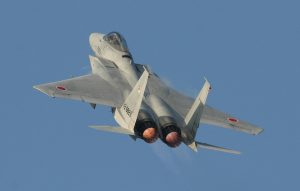The Japan Air Self-Defense Force (JASDF) scrambled its fighter aircraft a total of 446 times in the first half of fiscal year 2022 in response to foreign military aircraft approaching the country’s airspace: an increase of 14 percent compared with the same period last year.
The Ministry of Defense (MoD) in Tokyo said in an October 14 statement that there were 56 more scrambles during the past six months than during the first half of FY 2021, with the latest figure representing the highest number of scrambles in a six-month period since FY 2019. The highest total ever recorded in the first half of any fiscal year was 594 in FY 2016.
Most notably, JASDF fighters responded 340 times (76 percent of the total) to movements by Chinese aircraft in the area between April and the end of September, up 59 compared with the same period in 2021, according to the latest data.
The latest announcement comes amid continuing tensions between Japan and China over the disputed Senkaku/Diaoyu Islands, which are controlled by Tokyo but also claimed by Beijing. In addition, a Taiwan contingency has become an increasingly real possibility in recent months.
The number of scrambles against Chinese aircraft “is relatively high even in recent years, and we will continue to closely monitor the activities of Chinese aircraft and take all possible measures to ensure vigilance and surveillance,” Japan’s Defense Minister Hamada Yasukazu said at a press conference on October 14.
Tokyo also scrambled fighters 95 times (21 percent of the total) in response to Russian aircraft, down seven from the same period last year and the lowest since FY2013.
Among the People’s Liberation Army (PLA) aircraft spotted approaching Japanese airspace during this period were several Chinese unmanned aerial vehicles (UAVs).
For instance, on August 4 when the Chinese military fired ballistic missiles around Taiwan in a response to U.S. House Speaker Nancy Pelosi’s visit to the self-ruled island, one BZK-005 medium-altitude long-endurance (MALE) UAV and one TB-001 MALE UAV flew over the Miyako Strait, which is located between Okinawa’s main island and Miyako Island, more than once reaching the south of the Sakishima islands before reversing back on the same route, the MoD said. The islands are located in southern Okinawa near the East China Sea area. On the same day, a third unmanned aircraft was seen flying off the northeastern coast of Taiwan and continued to circle over the “high seas,” the MoD added.
On May 24, the JASDF also intercepted a joint flight made by four Xian H-6 Chinese strategic bombers and two Russian Tu-95 strategic bombers that overflew near the Japanese archipelago ‒ an apparent bid to warn against the Quad summit, held the same day, involving the leaders of Australia, India, Japan, and the United States. In addition, one Russian Il-20 electronic intelligence aircraft was spotted flying over the Sea of Japan on the same day.
In its 2022 Defense White Paper published in July, Japan expressed “strong concerns” over China’s activities in the East and South China Seas. It also stressed the need to “monitor with concern the Russian military movements in the Far East, including the Northern Territories.”

































